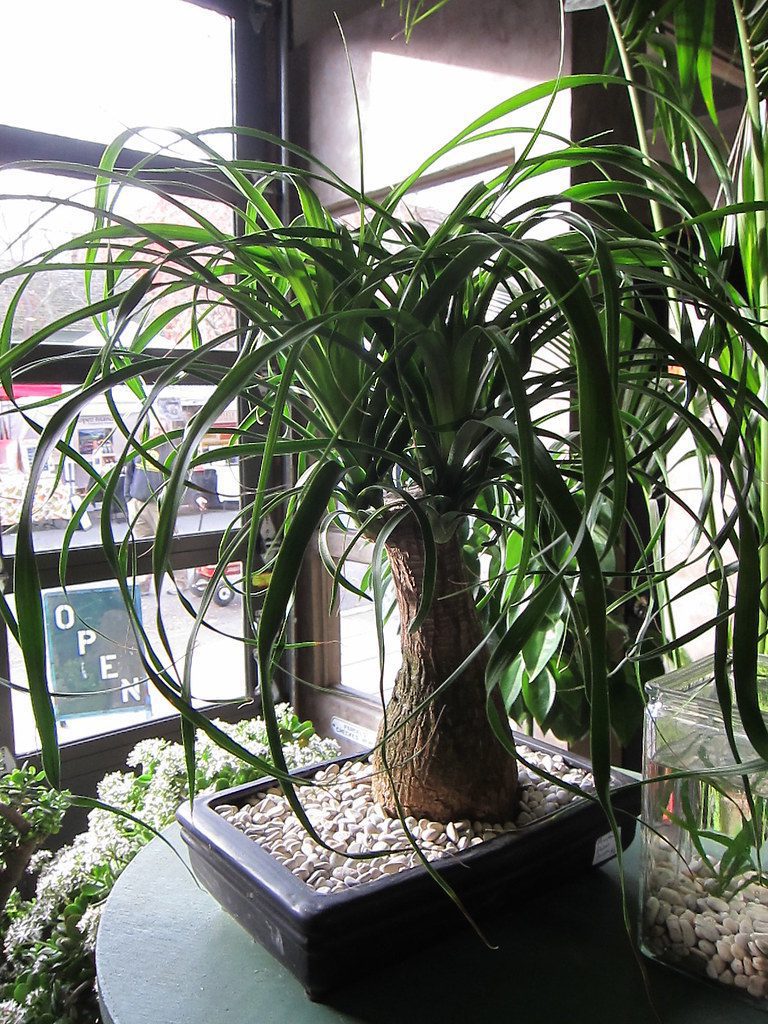Ponytail palms are popular houseplants known for being really easy to care for even for the most inexperienced houseplant owner. They’re also super cute with their characteristic, perky “ponytail” shape!
Whether you’re a houseplant novice or a seasoned pro, a ponytail palm is a great addition to your indoor plant collection!
Here’s how to care for your own ponytail palm, and some fun facts about this cute and funky houseplant.
All About the Ponytail Palm

This first fact may come as a shocker, but the ponytail isn’t actually a palm at all. It’s also not a tree even though it’s often called a ponytail palm tree. It’s actually a succulent!
Also called the elephant’s foot palm or bottle plant, Beaucarnea recurvata is native to eastern Mexico and can grow to over 20 feet tall outside. But don’t worry. This plant grows very slowly and will stay under three feet indoors.
The bulbous base stores water, which allows this plant to go several weeks between waterings without a problem. This plant is also completely non-toxic, so it’s a great choice if you have pets or curious children who might nibble on your houseplants.
How to Care for a Ponytail Palm
Ponytail palms are some of the most easygoing plants around, so they don’t require a lot of special care. Here’s all you need to do:
Potting and Soil
Plant your ponytail palm in fast-draining soil like cactus mix, in a pot that’s just an inch or two larger than the root ball. Make sure the pot has drainage as well. Any pot material is fine, but terracotta is a good choice if you’re prone to overwatering your plants because it absorbs moisture from the soil.
Light
These guys aren’t fussy about their light conditions. They love full sun as well as partial sun, but you can also keep them in low light if that’s what you have. They’ll just grow slower, which isn’t necessarily a bad thing.
You can also put these plants outside as long as the temperatures don’t get below 40 degrees Fahrenheit. If you do this for half the year, you can bring them in for the winter and they’ll be fine in nearly any light for that time.

Water
Ponytail palms are desert plants, so make sure to water sparingly. Wait until the soil is completely dried out before you water, and then add water to the soil until it just starts to drain. This might be every two weeks or even longer in the winter! As long as you don’t overwater, you’ll be fine.
Fertilizer
These plants aren’t heavy feeders, so you’ll only need to fertilizer two or three times per year in the spring and summer. Indoor Plant Food works great for this!
Temperature and Humidity
Ponytail palms thrive in dry conditions and they aren’t fussy about temperature. As long as it doesn’t get extremely hot or cold, your little ponytail pal will be happy. Just make sure to keep it away from vents, furnaces, and drafts, as this will dry out the leaves.
Propagation
Like many succulents, ponytail palms propagate themselves by sending out offshoots, or “pups”. To separate a pup from the mother plant, simply cut it off with a clean, sharp knife. You might need to move some of the soil around from the base of the plant to access the bottom of the pup. Wait until the pup is at least 4 inches tall to ensure that it’s already partially rooted.
Plant the pup in dap cactus soil and mist the surface of the soil every few days. That’s it!
Troubleshooting
The main thing with ponytail palms is to make sure you haven’t overwatered them. If the leaves start yellowing or turning dark, you may have given it too much! If that happens, repot the plant in dry soil to give it a chance to heal, and make sure it gets plenty of light.
If the ends of the leaves start to brown, carefully trim off the dead parts with sharp, clean shears.
That’s it! These plants are extremely easy to care for any will thrive in nearly any indoor environment. Give one a try and let us know how it goes!




